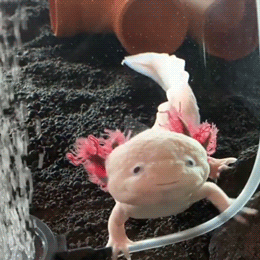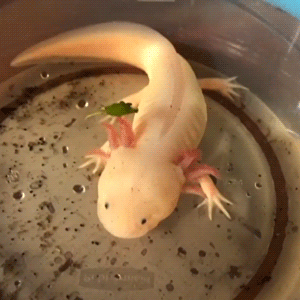Ranking Of Roundest Frogs
Ranking of Roundest Frogs
11. Australian green tree frog, Litoria caerulea
v smooth and plump. more photogenic than most people

10. Tomato frog, Genus: Dyscophus
only looks like a tomato. do not eat them. beautiful smile

9. Turtle frog, Myobatrachus gouldii
great lil dude. is not a turtle, only a frog

8. Budgett’s frog, Genus: Lepidobatrachus
all around great guy. was in a meme once

7. African bullfrog, Pyxicephalus adspersus
bumpy green dude

Argentine horned frog, Ceratophrys ornata
green pancake friend. nice red eyeliner

5. Banded bullfrog, Kaloula pulchra
bonus double throat pancake

4. Purple frog, Nasikabatrachus sahyadrensis
has a weird nose and i love them

3.Black rain frog, Breviceps fuscus
angry round friend

2. Holy Cross Frog, Notaden bennettii
perfect spotty orb

1. Desert rain frog, Breviceps macrops
the roundest of all

More Posts from Linruuu and Others
No kissy hooman 😼
(via)
Parasitic crustaceans are wild.
[cw: photos of parasites inside host bodies]

Here is Linguatula serrata, which lives inside the nose of dogs and other Carnivorans. It belongs to group Pentastomida, which has so shed its arthropod appendages that it was long classified as its own independent phylum (attested in fossils all the way from the Cambrian Explosion!), until molecular analyses showed they were in fact strange crustaceans – closest relatives of the relatively normal-looking fish lice (Branchiura).
And then there’s Pennellidae…

Do those horn-things look like crustaceans to you? And yet the family Pennellidae is fully part of Copepoda, the chief component of crustacean plankton. Its body is simply one elongated trunk and a tiny head biting onto the fish, with two long egg cords trailing behind.
Look at the cod worm (Lernaeocera branchialis), another Pennellidae, hanging from the gills of a fish:

It’s those two red things that look like slugs wearing a wig made of soy noodles. Here’s what it looks like on its own, extracted and preserved:

(source) The coiled strings are egg masses. The slug-like part is the copepod’s trunk. The thin branching thing at the bottom is its head, converted into a sort of root system that no longer does head-like things, but rather burrows into the fish host’s blood vessels to feed its eggs. Incidentally, this is just the female; the male still looks like a regular planktonic crustacean.
Now, regular barnacles (Cirripedia) are strange enough…

(source; picture them as shrimps lying on their back, with a digestive system that fell out of the body wall but is still contained by the outer shell, and feathery legs poking out to filter water)
… but parasitic barnacles of clade Rhizocephala go much further:

Here, on the left, is Sacculina carcini. No, not the crab; the yellow sac poking out of the crab’s belly. On the right, its relative Clistosaccus paguri shows what it might look like once extracted.
Sacculina carcini is fun. A larva looks much like any other crustacean planktonic larva, until it finds a suitable host. It stings the unfortunate crab in a vulnerable spot between armor plates, and effectively injects itself into the host, leaving its own shell outside, and transferring only soft tissues.
Once inside, it grows more like a fungus than an animal, turning into a root-like web that infests the crab’s entire body, down to its leg tips. Then it takes over not only the crab’s digestive system, leeching nutrients for its own eggs, but also its nervous system, effectively controlling it like a puppet.
When the parasite is mature, its egg sac starts bulging out of the crab’s body: that’s the yellow part you see in the photo. Male Sacculina stay larvae their whole life: they just mate with the female’s egg sac and then die. The parasite makes the crab take care of itself as if it was the crab’s own eggs. There’s no competition, since the host is sterilized; to leave more food for the parasite, it also stops molting and regenerating lost limbs. If the host is male, and therefore poorly suited to carrying egg sacs under its tail, Sacculina messes with its hormones and effectively turns it female.
Finally the eggs are released and the whole cycle starts again, with the only purpose of making more eggs whose purpose is making more eggs.
(all pictures from Wikipedia unless specified otherwise)
spiny lobster conga line😎
Ever seen a hedgehog stretch?
You’re Welcome! 🦔
marie antoinette was a clueless teenage girl thrown into a marriage and country she had no choice in, and has been slandered for hundreds of years since her death, with made up quotes such as “let them eat cake” when her final words were actually apologising to a guard for stepping on his toes, the fact that despite the extravagance she was much less fancy and money wasting than previous royals, and the erasure of her efforts to listen to and help the people despite having no political experience and her king-husband being useless, all providing a perfect example of the sexualised demonisation of young women with any semblance of power throughout history, and in this essay i will
i already knew a woodpecker’s tongue wraps around its skull when retracted but just now learned that the reason for that is to provide cushioning from the impacts of wood pecking. what the fuck. imagine your tongue being a shock absorber









axolotl stim board
for anon - credits below - all gifs made by me
Keep reading



I like the corner seat.
僕は隅っこに座るのが好き。

Xray: shows bone/skull only. Does not show the brain. Best used to detect if there are bone fractures. CT: quick test. Shows brain but detail not great. Shows if any larger bleed, stroke, lesions, or masses. MRI: long test. Shows brain and detail is great. Shows smaller bleeds, stroke, lesions, or masses. MRA: shows the flow of blood in the vasculature system of the brain. If there is vessel narrowing or blockage this test would show it. PET scan: shows how active different parts of the brain is. An active brain uses sugar as energy and pet scan detects how much sugar is being used by lighting up and turning different colors. The more sugar being used the more that area will light up and be different in colors. Cancer cells use the most sugar so cancer cells light up the most. PET scan is used to see if there are cancer cells. (Cancer cells replicate at a very fast and uncontrolled rate hence use a lot of sugar to allow that replication hence why they light up so much).
Via Meddy Bear
What in the world are you?
(via)
-
 fastofthekillones reblogged this · 2 weeks ago
fastofthekillones reblogged this · 2 weeks ago -
 fastofthekillones liked this · 2 weeks ago
fastofthekillones liked this · 2 weeks ago -
 ilovebearsandmydoghenry liked this · 2 months ago
ilovebearsandmydoghenry liked this · 2 months ago -
 myfunstuffz reblogged this · 2 months ago
myfunstuffz reblogged this · 2 months ago -
 tinmandyke reblogged this · 3 months ago
tinmandyke reblogged this · 3 months ago -
 superpaperclip reblogged this · 5 months ago
superpaperclip reblogged this · 5 months ago -
 superpaperclip liked this · 5 months ago
superpaperclip liked this · 5 months ago -
 megalokalypse liked this · 5 months ago
megalokalypse liked this · 5 months ago -
 im-da-bronx reblogged this · 5 months ago
im-da-bronx reblogged this · 5 months ago -
 goblindigitalhoard reblogged this · 5 months ago
goblindigitalhoard reblogged this · 5 months ago -
 kinda-wanna-kiss-your-gf reblogged this · 6 months ago
kinda-wanna-kiss-your-gf reblogged this · 6 months ago -
 kinda-wanna-kiss-your-gf liked this · 6 months ago
kinda-wanna-kiss-your-gf liked this · 6 months ago -
 rainbow-flavoured-skittles reblogged this · 6 months ago
rainbow-flavoured-skittles reblogged this · 6 months ago -
 let-me-ascend reblogged this · 6 months ago
let-me-ascend reblogged this · 6 months ago -
 slate-withtheblankstare liked this · 6 months ago
slate-withtheblankstare liked this · 6 months ago -
 esmeralda-anistasia reblogged this · 6 months ago
esmeralda-anistasia reblogged this · 6 months ago -
 esmeralda-anistasia liked this · 6 months ago
esmeralda-anistasia liked this · 6 months ago -
 age-of-utopia liked this · 6 months ago
age-of-utopia liked this · 6 months ago -
 grapeagata reblogged this · 6 months ago
grapeagata reblogged this · 6 months ago -
 grapeagata liked this · 6 months ago
grapeagata liked this · 6 months ago -
 techs-sideblog reblogged this · 6 months ago
techs-sideblog reblogged this · 6 months ago -
 techs-sideblog liked this · 6 months ago
techs-sideblog liked this · 6 months ago -
 raptorbricks reblogged this · 6 months ago
raptorbricks reblogged this · 6 months ago -
 ribarel reblogged this · 6 months ago
ribarel reblogged this · 6 months ago -
 enirb0r3h liked this · 6 months ago
enirb0r3h liked this · 6 months ago -
 justanartisticpagan reblogged this · 6 months ago
justanartisticpagan reblogged this · 6 months ago -
 meignificent liked this · 6 months ago
meignificent liked this · 6 months ago -
 eyecandyeoz liked this · 6 months ago
eyecandyeoz liked this · 6 months ago -
 oftengruntled liked this · 6 months ago
oftengruntled liked this · 6 months ago -
 xanana reblogged this · 6 months ago
xanana reblogged this · 6 months ago -
 the-chains-are-the-easy-part reblogged this · 6 months ago
the-chains-are-the-easy-part reblogged this · 6 months ago -
 the-chains-are-the-easy-part liked this · 6 months ago
the-chains-are-the-easy-part liked this · 6 months ago -
 schrodingersraven reblogged this · 6 months ago
schrodingersraven reblogged this · 6 months ago -
 schrodingersraven liked this · 6 months ago
schrodingersraven liked this · 6 months ago -
 unicorn-bl00dxd liked this · 6 months ago
unicorn-bl00dxd liked this · 6 months ago -
 quinquangularist reblogged this · 6 months ago
quinquangularist reblogged this · 6 months ago -
 inkmaze liked this · 6 months ago
inkmaze liked this · 6 months ago -
 bleeding-heartbutch reblogged this · 6 months ago
bleeding-heartbutch reblogged this · 6 months ago -
 gijyser liked this · 6 months ago
gijyser liked this · 6 months ago -
 evalynevalyn reblogged this · 8 months ago
evalynevalyn reblogged this · 8 months ago -
 evalynevalyn liked this · 8 months ago
evalynevalyn liked this · 8 months ago -
 ambergreyowl liked this · 8 months ago
ambergreyowl liked this · 8 months ago -
 disastr0 reblogged this · 8 months ago
disastr0 reblogged this · 8 months ago -
 disastr0 liked this · 8 months ago
disastr0 liked this · 8 months ago -
 lolbotomite reblogged this · 8 months ago
lolbotomite reblogged this · 8 months ago -
 lolbotomite liked this · 8 months ago
lolbotomite liked this · 8 months ago -
 purpl3tortois3 reblogged this · 10 months ago
purpl3tortois3 reblogged this · 10 months ago
